151st ASA Meeting, Providence, RI
Intensity Of The American Alligator (Alligator Mississippiensis) Vocal Courtship Display: Evidence For Saccular (Non-Cochlear) Hearing In Crocodilian Vocal Communication
Neil Todd - neil.todd@manchester.ac.uk
Popular version of paper 5aABa6
In this talk I will present results from a study conducted at the Australian Reptile Park north of Sydney in NSW on the local population of American alligators (http://www.reptilepark.com.au). The goal of the study was to carry out an acoustic analysis of alligator vocal displays recorded simultaneously by air and water microphones, in order to estimate the role of the sacculus in acoustic communication. The sacculus is the primary organ of hearing in fish but it is present in all classes of vertebrate including mammals. In reptiles and mammals (including humans) it is, however, traditionally associated with that part of the inner which helps to maintain balance, and is separate from the cochlea, the structure primarily associated with hearing. Studying alligator communication can provide powerful insights into the question of what function, if any, might be served through the presence of a primitive "fish ear" in higher vertebrates (Todd and Merker, 2004). 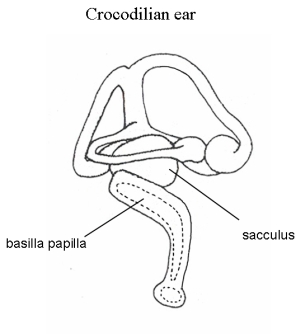 Figure 1. A diagram of a crocodilian ear, adapted from Lewis, Leverenz and Bialek (1985, The Vertebrate Inner Ear (CRC, Boca Raton, FL).  Figure 2. An alligator at the Australian Reptile Park adopting the head arched tail oblique (HOTA) posture. Crocodilians are interesting animals to study with regard to the above question. They are aquatic, highly vocal and have a large sacculus (Figure 1). Alligators in particular are known to be one of the most vocal species (Vliet, 1989) and produce a loud roaring call referred to as a bellow. Bellows are performed from a "head oblique tail arched" (HOTA) posture (Figure 2). Alligators spontaneously bellow after dawn throughout the year but are most active during the spring courtship season and less active in winter. Both males and females bellow and often together in choruses. Males, though, tend to have an infrasound component, referred to as sub-audible vibrations (SAV), just prior to the audible bellow. Bellowing is thought to serve as an attractant to alligators of opposite sex and to space out animals of same sex.
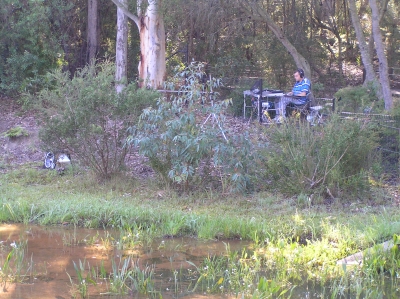 Figure 3.The author Dr Todd manning his field lab at the Australian Reptile Park for recording and playing back alligator calls. The sub-woofer (or "croc blaster") is placed at the edge of the alligator pond. While bellowing is a spontaneous activity, studying the animals out of season is made easier by the fact that they can be easily induced to vocalize by playing of recorded alligator calls. In my own study playback was done by means of an adapted car stereo system with a sub-woofer speaker, the "croc blaster" system (Figure 3). Analysis of such induced vocalizations recorded on twelve sessions during March to May indicate that most of the power in adult vocalizations is well below 100 Hz particularly in water. Typically the dominant frequencies in water are between 30 - 50 Hz, and for adult males the SAV are less than 20 Hz. As well as being very low frequency they are also very loud. At 1 m distance peak sound pressure levels of near to 140 dB can be obtained in water.
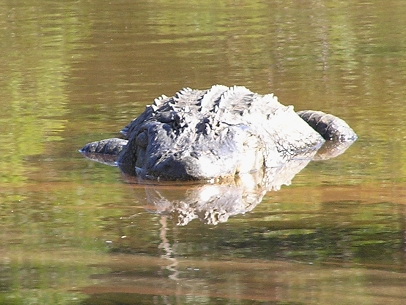 Figure 4. The dominant male from the alligator population at the Australian Reptile Park. 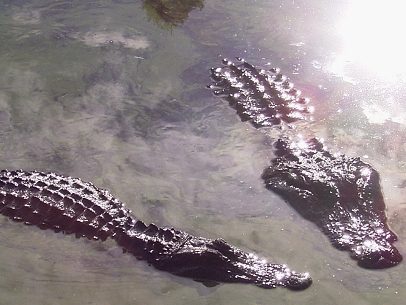 Figure 5. The dominant male and female companion from the alligator population at the Australian Reptile Park. In the accompanying sound examples you can hear two of my star performers, the dominant male of the Australian Reptile Park population (Figure 4) and one of his female companions (Figure 5). An interesting feature of these recordings is that as well as the male and female calls being quite distinct, the calls sound very different when recorded in air and water. In air one can hear higher frequency sounds, and it is these that we can use to tell the animals apart, a bit like the formants (acoustic frequency components) of human speech. Below water, however, predominantly low frequency sounds are transmitted, and unless your PC is hooked up to a good woofer it is unlikely that you'll hear anything much at all! The waveform and spectrum of these sounds are shown in Figures 6 and 7.
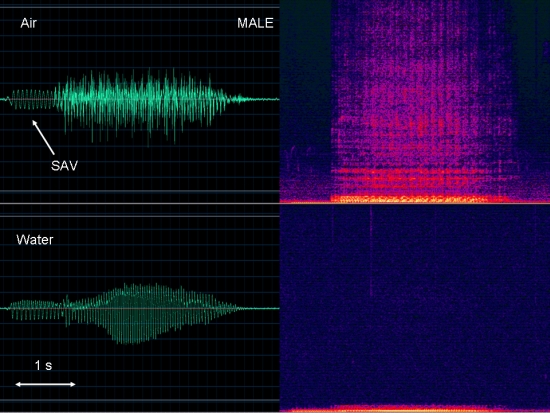 Figure 6. The waveform (left) and spectrum (right) of a sound sample of the male alligator bellow recorded in air (top) and water (bottom). Male Alligator Recorded in Air Male Alligator Recorded Underwater 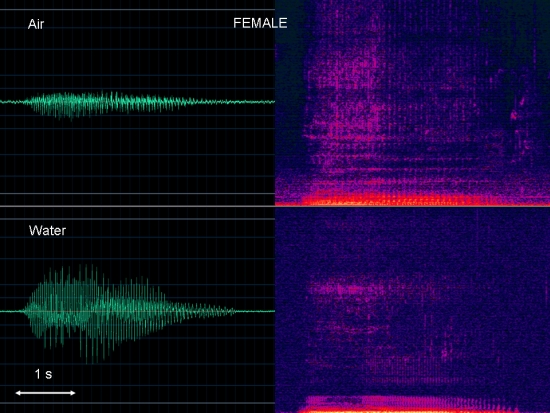 Figure 7. The waveform (left) and spectrum (right) of a sound sample of the male alligator bellow recorded in air (top) and water (bottom). Female Alligator Recorded in Air Female Alligator Recorded Underwater Previous studies of alligator hearing in air and water have assessed audiograms down to only 100 Hz and indicate a maximum sensitivity between 800 Hz and 1000 Hz (Higgs et al 2002). The results that the dominant frequencies in alligator calls are well below this optimum range of sensitivity for hearing, leave the very real possibility that the basilar papilla (the equivalent of the mammalian cochlea) may not be the primary receptor in crocodilian water-borne communication. One possibility is that skin receptors in the face region, the "dome pressure receptors" (DPRs), may be the primary receptor for these vocalizations (Soares, 2002). However, the vocal displays do not produce significant surface waves, which are the effective stimulus for the DPRs, and most of the acoustic energy produced by the vocal displays is the kinetic energy of the acoustic particle motion. That leaves only the sacculus, which is especially sensitive to movement or acceleration, as the effective receptor. In fish and frogs, an acoustic pathway to reward centers in the brain mediated by the sacculus is specifically engaged in reproductive vocal behavior. Alligator bellowing is known to be associated with powerful reproductive responses and smell signals via musk glands. A primitive saccular autonomic (involuntary) signal pathway in crocodilians conserved from an equivalent system in a fishy/amphibian ancestor would therefore appear to serve as an ideal mechanism for mediating vocal courtship responses in these animals. The alligators are ancient representatives of the archosaurs (or ruling reptiles), which include both dinosaurs and birds, a group whose ears are quite similar in structure, along with other similarities, such as egg laying, parenting and vocal behavior. If the primitive hearing mechanism is proven to be present in this group, as well as in fish and amphibians, then it is likely that it is widespread in all vertebrates, including in mammals and humans. Given its likely role in mediating reproductive vocal behavior then it may well have played a central, but hitherto overlooked, role in evolution. References Higgs, D.M., Brittan-Powell, E.F., Soares, D., Souza, M.J., Carr, C.E., Dooling, R.J. and Popper, A.N. (2002) Amphibious auditory responses of the American alligator (Alligator mississippiensis). Journal of Comparative Physiology A 188, 217 - 223. Soares, D. (2002) An ancient sensory organ in crocodilians. Nature 417, 241-242. Todd, N.P.M. and Merker, B. (2004) Siamang gibbons exceed the saccular threshold. Journal of the Acoustical Society of America 115(6), 3077-3080. Vliet, K.A. (1989) Social displays of the American alligator (Alligator mississippiensis). American Zoologist 29, 1019-1031. Acknowledgements I am indebted to the Australian Reptile Park for permission to record the alligators and to keeper Craig Adams for assistance in obtaining the recordings. I am also grateful to Dr Doug Cato of the Australian Defence Science and Technology Organisation (DSTO) for technical assistance in making the underwater recordings. |